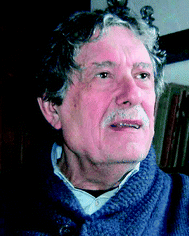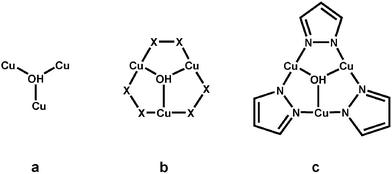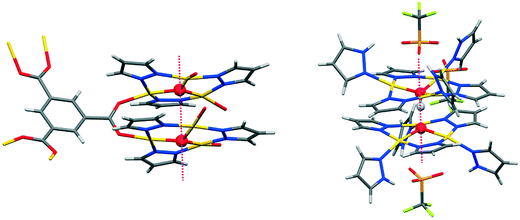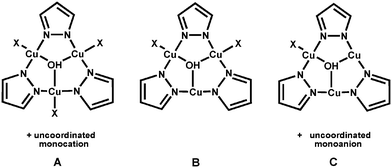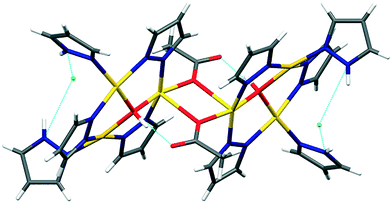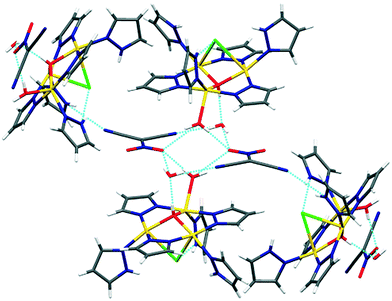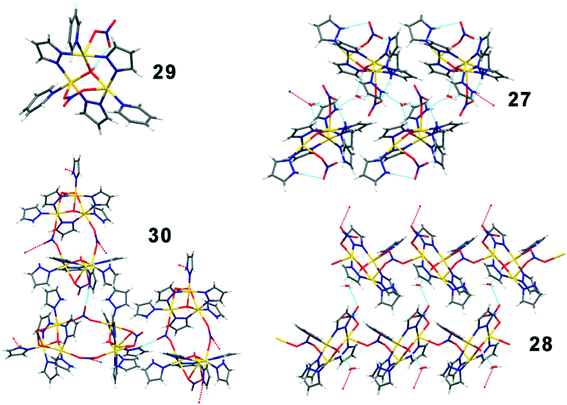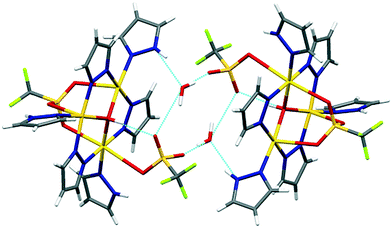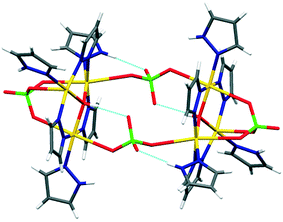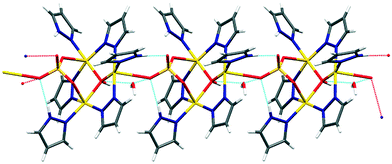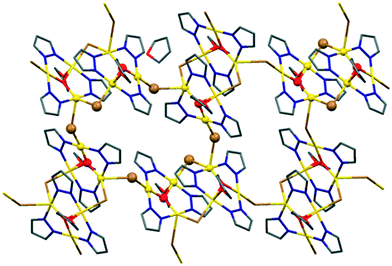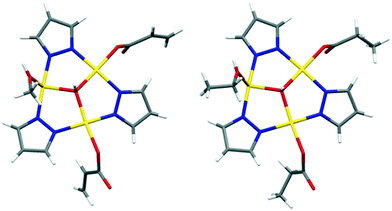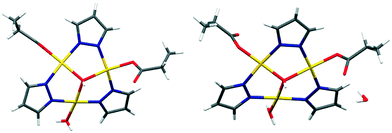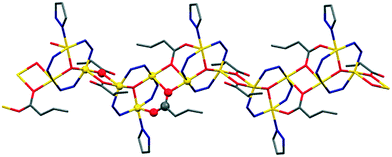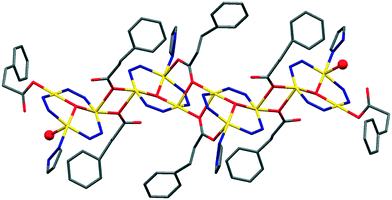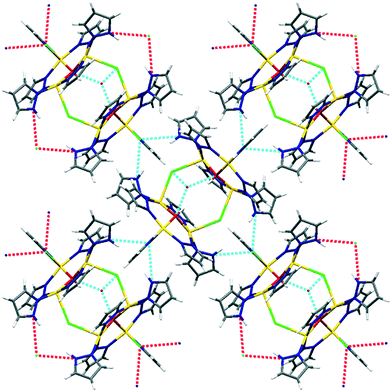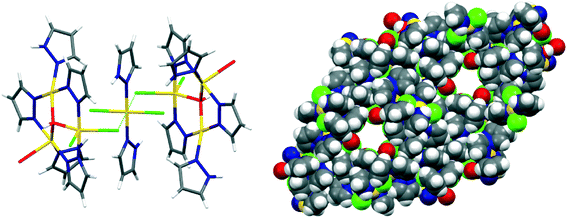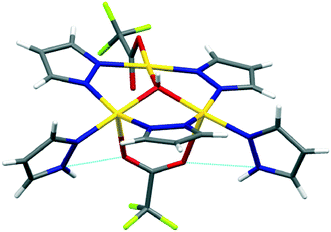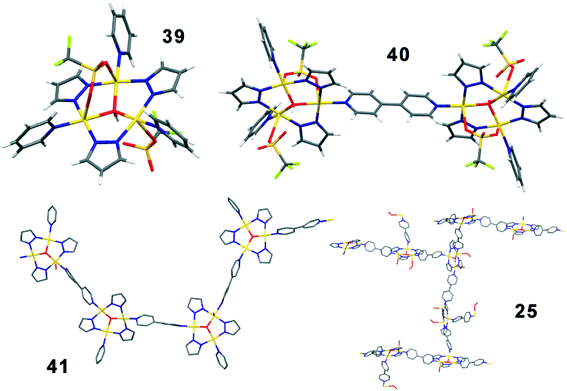Trinuclear copper(II) pyrazolate compounds: a long story of serendipitous discoveries and rational design†
Luciano
Pandolfo
 *a and
Claudio
Pettinari
*a and
Claudio
Pettinari
 *b
*b
aDipartimento di Scienze Chimiche, Università di Padova, Via Marzolo, 1, I-35131 Padova, Italy. E-mail: luciano.pandolfo@unipd.it
bScuola di Farmacia, Università di Camerino, Via S. Agostino, 1, I-62032 Camerino (MC), Italy. E-mail: claudio.pettinari@unicam.it
First published on 2nd February 2017
Abstract
In the past decade great effort has been put into the development of synthetic strategies to produce trinuclear triangular CuII (TTC) arrays, which may be synthetic analogues of the trinuclear site in ascorbate oxidase and blue oxidase. A large number of scientific contributions have been dedicated to the synthesis and spectroscopic characterization of TTC arrays. In contrast, only a small number of studies deal with their possible applications. As a consequence, systematic studies describing their reactivity are very rare and the few existing models can only partially explain how structural and molecular parameters influence their reactivity and their possible uses and applications. This contribution reports a summary of all experimental results related to the Cu3(μ3-OH)(μ-pz)3 core (pz = unsubstituted pyrazolate). We describe here all species, distinguishing them according to whether they are neutral, cationic or anionic, as well as their main structural features, the synthetic procedures employed for their production, their reactivity toward nucleophiles and strong acids and, finally, their possible and perspective applications.
Introduction
Polynuclear copper(II) assemblies are continuing to attract the attention of researchers, mainly due to their possible catalytic activity,1–10 and magnetic properties,11–20 and the fact that they are present in some naturally occurring metalloproteins, such as laccase and ascorbate oxidase, which are able to catalyze the oxidation of specific substrates such as polyphenols and aromatic amines in living organisms through the four-electron reduction of atmospheric dioxygen to water.21–28 Thus, the study of polynuclear copper(II) complexes is continuing to attract relevant interest and, in this context, obtaining and characterization of trinuclear triangular CuII arrays have been, and continue to be, the object of a huge number of studies. Particularly, numerous trinuclear triangular copper complexes possessing a Cu3(μ3-OH) core have been reported and structurally characterized. In detail, the CCDC database returns more than 600 entries where the Cu3(μ3-OH) core (Chart 1a) is present. In 175 of them, each copper ion is further connected by a couple of X donor atoms (X = O or N) belonging to three ditopic ligands (Chart 1b),29 which are often azolates (129 entries). In most cases, the bridging ditopic ligands are pyrazolates (87 entries), 76 of which are unsubstituted, while in 42 cases tri- or tetra-azolates are involved. Here we will review the most relevant structural features of compounds characterized by the trinuclear hydroxocluster Cu3(μ3-OH)(μ-pz)3 (pz = pyrazolate) (TTC),‡ where copper(II) ions are bridged by three unsubstituted pyrazolates, besides the capping μ3-hydoxido group (Chart 1c).First of all, it is noteworthy that despite the structure shown in Chart 1c seems to have a three-fold axis passing through the O and perpendicular to the plane defined by the three Cu ions, this feature is actually only present in two compounds, catena-((μ6-benzene-1,3,5-tricarboxylato)-(μ3-hydroxido)-(μ3-oxido)-hexakis(μ-pyrazolato)-hexa-copper(II)),301,§ and (μ3-hydroxido)-tris(μ-pyrazolato-N,N′)-tris(1H-pyrazole-N2)-tri-copper(II)(μ3-oxido)-tris(μ-pyrazolato-N,N′)-tris(1H-pyrazole-N2)-tri-copper(II) tris(trifluoromethanesulfonate), 2.31 In both compounds, the Cu3(μ3-O)(μ-pz)3 moiety faces a TTC fragment (Fig. 1), and the threefold axis overlaps the segment joining the oxygen atoms.
In all TTC derivatives the oxygen is placed out of the plane established by the three Cu ions by about 0.2–0.6 Å, while in the [Cu3(μ3-O)] moieties the oxygen lies in that plane, as found in all compounds containing this specific fragment, including bis(triphenylphosphine)iminium bis(μ3-oxido)-tris(μ-3,5-diphenylpyrazolato)-hexakis(μ-pyrazolato)-hexa-copper(II), 3,32 tetra-n-butylammonium (μ3-oxido)-tris((μ-pyrazolato-N,N′)-(benzoato-O))-tri-copper(II), 4,33 and catena-((μ3-oxido)-(μ3-pyridine-3,4-dicarboxylato)-tris(μ-pyrazolato)-diaqua-methanol-tri-copper(II) unknown solvate), 5.34 In this context, it is to point out that in compound 2, the μ3-OH group is involved in a strong H-bond with the μ3-O belonging to the second trinuclear moiety (see Fig. 1), and this makes the μ3-O similar enough to a μ3-hydroxido moiety, placing it out of the Cu3 plane by about 0.43 Å.
The other relevant geometrical features pertaining to all the structurally characterized TTC moieties are quite normal. Excluding compounds 1 and 2, in all species the copper ions form isosceles or scalene triangles, with the non-bonding Cu⋯Cu distances falling between 3.08 and 3.46 Å. Analogously, the Cu–O and Cu–N bond distances are between 1.88–2.08 and 1.86–2.03 Å, respectively.
The TTC fragments are doubly positively charged and this charge can be differently balanced as schematized in Chart 2, where X indicates a monoanionic species, yielding anionic, neutral or cationic derivatives. Moreover, in a few cases, di- or trianionic species are present instead, and in almost all cases the copper ions also coordinate neutral molecules such as Hpz, water or other solvents, or mono or polytopic ligands such as pyridine or bipyridine, which are not evidenced in the structures sketched in Chart 2.
Ionic species
Considering only ionic species, the CCDC database reports 10 type A and 12 type C compounds. In the case of type A derivatives, the uncoordinated monocation is tetra-n-butylammonium (compounds 6–7,348–9,3510 (ref. 36) and 11 (ref. 37)), triethylammonium (compound 12 (ref. 38)), or (triphenylphosphino)iminium (compounds 13 (ref. 34) and 14–15 (ref. 36)), while in the case of type C the uncoordinated monoanion is chloride (compounds 16 (ref. 39) and 17 (ref. 40)), hydroxide (compounds 18–21 (ref. 41) and 22–23 (ref. 42)), trifluoromethanesulfonate (compounds 2,3124 (ref. 37) and 25 (ref. 43)) or dicyano(nitro)methanide (compound 26 (ref. 44)).Neutral species
Type B non-ionic species, where anions are coordinated to copper(II) ions, account for a larger number of compounds containing the TTC fragment, 54 entries. In detail, 18 derivatives bear inorganic anions, including nitrate (compounds 27,31,4528,31,4629 (ref. 47) and 30 (ref. 48)), chloride (compounds 31–32,3933 (ref. 49) and 34 (ref. 50)), bromide (compound 35 (ref. 51)), perchlorate (compounds 36 (ref. 31) and 37 (ref. 52)), trifluoromethanesulfonate (compounds 38 (ref. 31) and 39–41 (ref. 43)), sulfate (compound 42 (ref. 31)), phosphonate (compound 43 (ref. 47)) and sulfate plus nitrate (compound 44 (ref. 53)). Organic anions are instead present in 36 cases, including derivatives bearing formate (compounds 45–46 (ref. 41) and 47 (ref. 54)), acetate (compounds 48–49 (ref. 42) and 50 (ref. 55)), trifluoroacetate (compound 51 (ref. 31)), propanoate (compounds 52–53,754 (ref. 42) and 55 (ref. 54)), butyrate (compound 56 (ref. 54)), valerate (compound 57 (ref. 56)), hexanoate (compound 58 (ref. 56)), heptanoate (compound 59 (ref. 56)), acrylate (compounds 60–61 (ref. 42) and 62–63 (ref. 57)), methacrylate (compound 64 (ref. 57)), pivalate (compound 65 (ref. 58)), phenylacetate (compound 66 (ref. 58)), vinylacetate (compound 67 (ref. 58)), phenylpropanoate (compound 68 (ref. 58)), cyclohexylcarboxylate (compound 69 (ref. 58)), isocyanate (compound 70 (ref. 59)), fumarate (compound 71 (ref. 60)), 2-methylfumarate (compound 72 (ref. 60)), succinate (compounds 73–75 (ref. 61)), 2-hydroxynaphthalene-1,4-dicarboxylate (compound 76 (ref. 62)), biphenyl-4,4′-dicarboxylate (compound 77 (ref. 62)), 3-pyridine-3,4-dicarboxylate (compound 78 (ref. 62)), and benzene-1,3,5-tricarboxylate (compound 1 (ref. 30)). Moreover, in compound 79 (ref. 63) two TTC moieties, which face each other and are connected through three 3,5-diphenylpyrazolates, encapsulate a fluoride anion.| Entry | Identifier | Compound namea | Ref |
|---|---|---|---|
| a The compound names reported in Table 1 do not respect, in almost all cases, the 2005 IUPAC Recommendations for the Nomenclature of Inorganic Compounds. Nevertheless, we have maintained the compound names retrieved from the Structure Navigator of the Mercury 3.8 CCDC database, to avoid the possibility of a search of the CCDC database failing if the “correct” compound name is used. b For compounds 65–69 reported in ref. 58 the CCDC deposition numbers are indicated. c Atomic coordinates of compounds 76–78 (QOJZEW01, QOJZIA01 and QOKCOK01) (ref. 62) can be retrieved from the corresponding QOJZEW, QOJZIA and QOKCOK files, reported in the CCDC database as a personal communication. | |||
| 1 | HAWBIS | catena-((μ6-benzene-1,3,5-tricarboxylato)-(μ3-hydroxo)-(μ3-oxo)-hexakis(μ2-pyrazolato)-hexa-copper(II)) | 30 |
| 2 | QUSMIB | (μ3-Hydroxo)-tris(μ2-pyrazolato-N,N′)-tris(1H-pyrazole-N2)-tri-copper(II) (μ3-oxo)-tris(μ2-pyrazolato-N,N′)-tris(1H-pyrazole-N2)-tri-copper(II) tris(trifluoromethanesulfonate) | 31 |
| 3 | KEWRAG | bis(triphenylphosphine)iminium bis(μ3-oxo)-tris(μ2-3,5-diphenylpyrazolato)-hexakis(μ2-pyrazolato)-hexa-copper(II) | 32 |
| 4 | NESQOS | tetra-n-butylammonium (μ3-oxo)-tris((μ2-pyrazolato-N,N′)-(benzoato-O))-tri-copper(II) | 33 |
| 5 | XOBCEW01 | bis(bis(triphenylphosphine)iminium) (μ3-oxo)-tris(μ2-pyrazolato-N,N′)-trichloro-tri-copper(II) | 34 |
| 6 | RUYGIB | tetra-n-butylammonium (μ3-hydroxo)-tris(μ2-pyrazolato-N,N′)-trichloro-tri-copper(II) | 34 |
| 7 | RUYHEY | triethylammonium (μ3-hydroxo)-tris(μ2-pyrazolato-N,N′)-pyrazole-trichloro-tri-copper(II) | 34 |
| 8 | LUDZIV | bis(tetra-n-butylammonium) octakis(μ-hydroxo)-octadecakis(μ-pyrazolato)-pentadeca-copper diphosphate bromobenzene nitrobenzene solvate | 35 |
| 9 | LUDZOB | bis(tetra-n-butylammonium) octakis(μ-hydroxo)-octadecakis(μ-pyrazolato)-pentadeca-copper diarsenate bromobenzene nitrobenzene solvate | 35 |
| 10 | MAFBOL | bis(tetrabutylammonium) bis((μ3-hydroxo)-(μ2-acetato-O,O)-bis(acetato-O)-tris(μ2-pyrazol-1,2-diyl)-tri-copper(II)) hexahydrate | 36 |
| 11 | XOKWUQ | bis(tetra-n-butylammonium) bis(μ3-hydroxo)-hexakis(μ2-pyrazolato-N,N′)-bis(μ2-thiocyanato-N,S)-tetrakis(isothiocyanato)-hexa-copper(II) | 37 |
| 12 | XEMYEV | bis(triethylammonium) bis(μ3-hydroxo)-bis(μ2-acetato-O)-hexakis(μ2-pyrazolyl)-tetrakis(acetato-O)-hexa-copper(II) benzene solvate | 38 |
| 13 | RUYGEX | bis(triphenylphosphine)iminium (μ3-hydroxo)-tris(μ2-pyrazolato-N,N′)-trichloro-tri-copper(II) tetrahydrofuran dichloromethane solvate | 34 |
| 14 | MAFBEB | bis(triphenylphosphino)iminium (μ3-hydroxo)-tris((μ2-pyrazol-1,2-diyl)-(isocyanato))-tri-copper(II) | 36 |
| 15 | MAFBIF | bis(bis(triphenylphosphino)iminium) bis((μ3-hydroxo)-(μ2-acetato-O,O)-aqua-bis(acetato-O)-tris(μ2-pyrazol-1,2-diyl)-tri-copper(II)) dihydrate | 36 |
| 16 | DIBXES | bis(μ3-hydroxo)-bis(μ2-acetato-O,O)-hexakis(μ2-pyrazolato-N,N′)-tetrakis(pyrazole-N2)-hexa-copper(II) dichloride dihydrate | 39 |
| 17 | YUYGUW | bis(μ3-hydroxo)-hexakis(μ2-pyrazolyl)-bis(μ2-chloroacetato)-tetrakis(pyrazole)-hexa-copper bis(chloride) | 40 |
| 18 | KEBBUQ | bis(μ3-hydroxo)-hexakis(μ2-pyrazolato)-bis(μ2-4,4′-bipyridine)-diaqua-tetrakis(4,4′-bipyridine)-bis(formato)-hexa-copper(II) dihydroxide 4,4′-bipyridine | 41 |
| 19 | KEBCAX | bis(μ3-hydroxo)-hexakis(μ2-pyrazolato)-bis(μ2-4,4′-bipyridine)-diaqua-tetrakis(4,4′-bipyridine)-bis(formato)-hexa-copper(II) dihydroxide benzene solvate | 41 |
| 20 | KEBCIF | bis(μ3-hydroxo)-hexakis(μ2-pyrazolato)-bis(μ2-4,4′-bipyridine)-diaqua-tetrakis(4,4′-bipyridine)-bis(formato)-hexa-copper(II) dihydroxide hemikis(4,4′-bipyridine) cyclohexane solvate | 41 |
| 21 | KEBCUR | bis(μ3-hydroxo)-hexakis(μ2-pyrazolato)-bis(μ2-4,4′-bipyridine)-diaqua-tetrakis(4,4′-bipyridine)-bis(formato)-hexa-copper(II) dihydroxide toluene solvate | 41 |
| 22 | RUGLEM | bis(μ-4,4′-bipyridine)-bis(μ-hydroxo)-hexakis(μ-pyrazolato)-bis(acetato)-diaqua-tetrakis(4,4′-bipyridine)-hexa-copper 4,4′-bipyridine dihydroxide dihydrate | 42 |
| 23 | RUGLIQ | bis(μ-4,4′-bipyridine)-bis(μ-hydroxo)-hexakis(μ-pyrazolato)-bis(acetato)-diaqua-tetrakis(4,4′-bipyridine)-hexa-copper 4,4′-bipyridine dihydroxide tetrahydrate | 42 |
| 24 | XOKXAX | (μ3-Hydroxo)-tris(μ2-pyrazolato-N,N′)-tris(pyridine-N)-tri-copper(II) bis(trifluoromethanesulfonate) acetone solvate | 37 |
| 25 | MUZRIJ | catena-[bis(μ3-hydroxo)-tris(μ2-4,4′-bipyridine-N,N′)-hexakis(μ2-pyrazolato-N,N′)-hexa-copper(II) tetrakis(trifluoromethanesulfonate) hexahydrate] | 43 |
| 26 | VIMYEX | (μ3-Hydroxy)-(μ2-chloro)-tris(μ2-pyrazole)-(aqua)-tris(1H-pyrazole)-tri-copper dicyano(nitro)methanide monohydrate | 44 |
| 27 | BOFLEP | (μ3-Hydroxy)-tris(μ2-pyrazole)-tetrakis(1H-pyrazole)-bis(nitrato)-di-copper monohydrate | 45 |
| 28 | BOZBIB | catena-(μ3-nitrato-O,O′,O′′)-(μ3-hydroxo)-1-nitrato-1,2:1,3:2,3-tris(μ2-pyrazolato-N,N′)-2,3-bis(pyrazole-N2)-tri-copper(II) monohydrate | 46 |
| 29 | MINZIU | (μ-Hydroxo)-tris(μ-pyrazolato)-(μ-nitrato)-tris(pyridine)-(nitrato)-tri-copper | 47 |
| 30 | ZOQGOB | bis((μ3-hydroxo)-(μ3-nitrato-O,O′)-(μ2-nitrato-O,O′)-tris(μ2-pyrazol-1,2-diyl)-tris(pyrazol-2-yl))-hexa-copper(II) | 48 |
| 31 | DIBXIW | catena-(bis(μ3-chloro)-bis(μ3-hydroxo)-hexakis(μ2-pyrazolato-N,N′)-diaqua-tetrachloro-hexakis(pyrazole-N2)-hepta-copper(II)) | 39 |
| 32 | DIBXOC | bis(μ3-hydroxo)-bis(μ2-chloro)-hexakis(μ2-pyrazolato-N,N′)-dichloro-hexakis(pyrazole-N2)-hexa-copper(II) monohydrate | 39 |
| 33 | QIMSIQ | (μ3-Hydroxy)-tris(μ2-pyrazole)-bis(1H-pyrazole)-(N,N-dimethylformamide)-dichloro-tri-copper (μ3-hydroxy)-(μ2-chloro)-tris(μ2-pyrazole)-bis(1H-pyrazole)-chloro-tri-copper N,N-dimethylformamide solvate | 49 |
| 34 | SIJKOL | (μ3-Hydroxo)-tris(μ2-pyrazole-N,N′)-(μ2-chloro)-chloro-bis(pyridyl)-tri-copper(II) pyridine solvate | 50 |
| 35 | BOLXEH | catena-((μ3-hydroxo)-bis(μ2-bromo)-tris(μ2-pyrazolato)-tetrahydrofuran-tri-copper tetrahydrofuran solvate) | 51 |
| 36 | QOPJIP | bis(μ3-perchlorato-O,O′,O′′)-bis(μ3-hydroxo)-bis(μ2-perchlorato-O,O′)-hexakis(μ2-pyrazolato-N,N′)-hexakis(pyrazole-N)-hexa-copper(II) ethanol methanol solvate dihydrate | 52 |
| 37 | QUSLOG | bis(μ3-hydroxo)-bis(μ3-perchlorato-O,O′,O′′)-bis(μ2-perchlorato-O,O′)-hexakis(μ2-pyrazolato-N,N′)-hexakis(pyrazole-N2)-hexa-copper(II) | 31 |
| 38 | QUSMUN | (μ3-Hydroxo)-(μ3-trifluoromethanesulfonato-O,O′,O′′)-tris(μ2-pyrazolato-N,N′)-tris(1H-pyrazole-N2)-(trifluoromethanesulfonato-O)-tri-copper(II) monohydrate | 31 |
| 39 | MUZQUU | (μ3-Hydroxo)-tris(μ2-pyrazolato-N,N′)-(μ2-trifluoromethanesulfonato-O,O′)-tripyridine-(trifluoromethanesulfonato-O)-tri-copper(II) hemihydrate | 43 |
| 40 | MUZRAB | bis(μ3-hydroxo)-(μ2-4,4′-bipyridine-N,N′)-hexakis(μ2-pyrazolato-N,N′)-tetrapyridine-hexa-copper(II) tetrakis(trifluoromethanesulfonate) | 43 |
| 41 | MUZREF | catena-[bis(μ3-hydroxo)-bis(μ2-4,4′-bipyridine-N,N′)-hexakis(μ2-pyrazolato-N,N′)-dipyridine-hexa-copper(II) tetrakis(trifluoromethanesulfonate) monohydrate] | 43 |
| 42 | QUSLEW | (μ3-Hydroxo)-tris(μ2-pyrazolato-N,N′)-(μ2-sulfato-O,O′)-tris(pyrazole-N2)-tri-copper(II) monohydrate | 31 |
| 43 | MINZOA | octakis(μ-(4-methylphenyl)phosphonato)-octakis(μ-hydroxo)-dodecakis(μ-pyazolato)-diaqua-tetrapyridine-octadeca-copper acetonitrile unknown solvate tetrahydrate | 47 |
| 44 | DOKKAQ | catena-((μ6-sulfato)-bis(μ3-hydroxo)-hexakis(μ2-pyrazolato-N,N)-bis(m2-nitrato)-hexakis(1H-pyrazole-N)-hexa-copper acetonitrile methanol solvate sesquihydrate) | 53 |
| 45 | KEBBOK | catena-(tetrakis(μ3-hydroxo)-dodecakis(μ2-pyrazolato)-(μ2-4,4′-bipyridine)-tetrakis(μ2-formato)-diaqua-tetrakis(formato)-dodeca-copper(II) decahydrate) | 41 |
| 46 | KEBDEC | catena-(bis(μ3-hydroxo)-hexakis(μ2-pyrazolato)-(μ2-4,4′-bipyridine)-bis(μ2-formato)-diaqua-bis(4,4′-bipyridine)-bis(formato)-hexa-copper(II) dihydrate) | 41 |
| 47 | JAVGAP | catena-((μ3-hydroxo)-(μ2-formato)-tris(μ2-pyrazole)-formato-bis(pyrazol-2-yl)-tri-copper(II) monohydrate) | 54 |
| 48 | RUGKUB | catena-[bis(μ-acetato)-bis(μ-4,4′-bipyridine)-bis(μ-hydroxo)-hexakis(μ-pyrazolato)-bis(acetato)-hexa-copper methanol solvate monohydrate] | 42 |
| 49 | RUGLAI | catena-[bis(μ-4,4′-bipyridine)-(μ-hydroxo)-tris(μ-pyrazolato)-bis(acetato)-aqua-tri-copper 4,4′-bipyridine methanol solvate tetrahydrate] | 42 |
| 50 | LAHYUP | catena-[(μ3-acetato)-(μ3-hydroxo)-(μ2-acetato)-tris(μ2-pyrazolyl)-(pyrazole)-tri-copper(II)] | 55 |
| 51 | QUSMEX | (μ3-Hydroxo)-tris(μ2-pyrazolato-N,N′)-(μ2-trifluoroacetato-O,O′)-bis(1H-pyrazole-N2)-(trifluoroacetato-O)-tri-copper(II) | 31 |
| 52 | JEWWEO | (μ3-Hydroxo)-tris(μ2-pyrazolato)-aqua-bis(propionato)-tri-copper(II) monohydrate | 7 |
| 53 | JEWWIS | (μ3-Hydroxo)-tris(μ2-pyrazolato)-aqua-bis(propionato)-tri-copper(II) | 7 |
| 54 | RUGLUC | catena-[bis(μ-4,4′-bipyridine)-bis(μ-hydroxo)-bis(μ-propanoato)-hexakis(μ-pyrazolato)-bis(propanoato)-hexa-copper dihydrate] | 42 |
| 55 | JAVGET | catena-((μ3-hydroxo)-(μ2-propionato-O,O)-(μ2-propionato-O,O′′)-tris(μ2-pyrazole)-ethanol-tri-copper(II)) | 54 |
| 56 | JAVGIX | bis((μ3-hydroxo)-(μ2-butyrato)-tris(μ2-pyrazole)-aqua-butyrato-methanol-tri-copper(II)) | 54 |
| 57 | HUTZED | catena-[(μ3-hydroxo)-tris(μ2-pyrazolyl)-(μ2-4,4′-bipyridine)-(μ2-valerato)-(valerato)-methanol-tri-copper] | 56 |
| 58 | HUTZON | catena-[(μ3-hydroxo)-(μ2-4,4′-bipyridine)-tris(μ2-pyrazolyl)-(μ2-hexanoato)-(hexanoato)-aqua-tri-copper] | 56 |
| 59 | FUPYOG | catena-[bis(μ-hydroxo)-bis(μ-heptanoato)-(4,4′-bipyridine)-hexakis(μ-pyrazolato)-bis(heptanoato)-hexa-copper] | 56 |
| 60 | RUGMEN | catena-[(μ-4,4′-bipyridine)-(μ-hydroxo)-(μ-acrylato)-tris(μ-pyrazolato)-(acrylato)-aqua-tri-copper] | 42 |
| 61 | RUGMOX | catena-[(μ-4,4′-bipyridine)-(μ-hydroxo)-tris(μ-pyrazolato)-(acrylato-O)-(acrylato-O,O′)-(4,4′-bipyridine)-(1H-pyrazole)-tri-copper dihydrate] | 42 |
| 62 | XUCRET | bis(μ3-hydroxo)-bis(μ2-acrylato-O,O)-hexakis(μ2-pyrazolato-N,N′)-bis(acrylato-O,O′′)-tetra-aqua-bis(pyrazole-N2)-hexa-copper(II) | 57 |
| 63 | XUCRIX | catena-((μ3-hydroxo)-(μ2-acrylato-O,O′′)-(μ2-acrylato-O,O)-tris(μ2-pyrazolato-N,N′)-methanol-tri-copper(II)) | 57 |
| 64 | XUCROD | catena-((μ3-hydroxo)-bis(μ2-methacrylato-O,O′′)-tris(μ2-pyrazolato-N,N′)-tri-copper(II)) | 57 |
| 65 | 1454767 | (μ3-Hydroxo)-tris(μ-pyrazolato)-bis(pivalato)-(pyrazole)-bis(pivalic acid)-tri-copper(II) | 58 |
| 66 | 1454763 | catena-((μ3-hydroxo)-bis(μ-phenylacetato-O,O′′)-tris(μ-pyrazolato-N,N′)-tri-copper(II)) | 58 |
| 67 | 1454764 | catena-((μ3-hydroxo)-(μ3-vinylacetato)-(μ-vinylacetato)-tris(μ-pyrazolato-N,N′)-tri-copper(II)) | 58 |
| 68 | 1454765 | bis((μ3-hydroxo)-(μ3-phenylpropanoato)-(μ-phenylpropanoato)-tris(μ-pyrazolato-N,N′′)-tri-copper(II))-bis((μ3-hydroxo)-(μ3-phenylpropanoato)-(μ-phenylpropanoato)-tris(μ2-pyrazolato-N,N′)-diaqua-tri-copper(II)) | 58 |
| 69 | 1454766 | catena-((μ3-hydroxo)-bis(μ-cyclohexylcarboxylato-O,O′′)-tris(μ-pyrazolato-N,N′)-tri-copper(II)) | 58 |
| 70 | DEGBAU | bis(μ3-hydroxo)-tetrakis(μ2-hydroxo)-hexadecakis(μ2-pyrazolato)-bis(isocyanato)-dodeca-copper methanol solvate | 59 |
| 71 | TAZWOI | catena-[(μ3-fumarato)-(μ3-hydroxo)-tris(μ2-pyrazolyl)-(1H-pyrazole-N2)-tri-copper(II)] | 60 |
| 72 | TAZWUO | catena-[(μ3-2-methylfumarato)-(μ3-hydroxo)-tris(μ2-pyrazolyl)-(1H-pyrazole-N2)-tri-copper(II)] | 60 |
| 73 | CENJIQ | catena-((μ3-succinato)-(μ3-hydroxo)-tris(μ2-pyrazolato)-aqua-(methanol)-tri-copper monohydrate unknown solvate) | 61 |
| 74 | CENKAJ | catena-((μ3-succinato)-(μ3-hydroxo)-tris(μ2-pyrazolato)-triaqua-tri-copper hemihydrate unknown solvate) | 61 |
| 75 | CENKEN | catena-((μ4-succinato)-(μ3-hydroxo)-tris(μ2-pyrazolato)-tri-copper) | 61 |
| 76 | QOJZEW01 | catena-[(μ-2-hydroxynaphthalene-1,4-dicarboxylato)-(μ-hydroxo)-tris(μ-pyrazolato)-tri-copper N,N-dimethylformamide methanol solvate monohydrate] | 62 |
| 77 | QOJZIA01 | catena-[(μ-biphenyl-4,4′-dicarboxylato)-(μ-hydroxo)-tris(μ-pyrazolato)-diaqua-tri-copper] | 62 |
| 78 | QOKCOK01 | catena-((μ3-oxo)-(μ3-pyridine-3,4-dicarboxylato)-tris(μ2-pyrazolato)-diaqua-methanol-tri-copper unknown solvate) | 62 |
| 79 | HUXWUU | tris(μ-3,5-diphenylpyrazolato)-(μ-fluoro)-bis(μ-hydroxo)-hexakis(μ-pyrazolato)-hexa-copper(II) unknown solvate | 63 |
| 80 | KEBBEA | catena-((μ3-methoxido)-tris(μ2-pyrazolato)-(μ2-4,4′-bipyridine)-(μ2-formato)-(formato)-tri-copper(II) methanol solvate) | 41 |
| 81 | FUPYIA | catena-[bis(μ-methoxo)-bis(μ-butanoato)-hexakis(μ-pyrazolato)-bis(μ-4,4′′-bipyridine)-bis(butanoato)-hexa-copper] | 56 |
| 82 | HUTZIH | catena-[bis(μ3-methoxy)-bis(μ2-4,4′-bipyridine)-bis(μ2-hexanoato)-hexakis(μ2-pyrazolyl)-bis(hexanoato)-hexa-copper] | 56 |
Synthetic procedures
The synthesis of compounds containing TTC fragments has been generally performed by reacting copper(II) salts with Hpz and water, which need to be deprotonated to give pz− and OH− anions, respectively. In some cases the deprotonation was achieved by adding an exogenous base such as NaOH,34,36,37,43,45,48,52,53 Bu4NOH,35 or Et3N.38,47 When copper salts of weak acids are employed (mono, di or tricarboxylates) the presence of the exogenous base is not needed, since the basicity of the carboxylates appears to be adequate to shift the deprotonation equilibria of Hpz and water toward the formation of pz− and OH− in an amount sufficient to enable the self-assembly of the TTC fragment,7,9,30,40,54,55,57,58,60–62 according to the reaction depicted in Scheme 1 for a generic monocarboxylate. In a few cases, the TTC assembly was instead achieved through the aerobic oxidation of copper(I) derivatives, including cyclic trinuclear Cu3(μ-pz)3 species, the mononuclear CuI(Hpz)2(NO3) complex and the dinuclear [CuI(Hpz)2(Cl)]2 complex, yielding the TTC-containing compounds 33,4928 (ref. 46) and 34,50 respectively.Structural description
Ionic compounds
The structures of ionic compounds all consist of discrete ionic couples. In the cases of type A derivatives (Chart 2), the cations often interact with the anionic TTC fragments through more or less strong non-covalent interactions, as shown in Fig. 2, where the structures of compounds 7 (ref. 34) (left) and 12 (ref. 38) are reported. In 7, N–Hammonium⋯Cl, N–Hpyrazole⋯Cl and O–H⋯Cl H-bonds generate a 1D supramolecular network, while in 12 two quite strong N–H⋯O H-bonds connect two ammonium cations to a hexanuclear motif obtained through two, symmetry equivalent, monatomic O acetate bridges. | ||
| Fig. 2 Structures of 7 (left) and 12 (right), where crystallization benzene molecules have been removed for clarity.¶ | ||
Similar supramolecular interactions are also present in type C compounds (Chart 2). As an example, compound 16 (ref. 39) is shown in Fig. 3, where Cl− ions interact with N–Hpyrazole fragments belonging to a hexanuclear system generated, analogously to 12, by two symmetry equivalent monatomic O acetate bridges connecting two TTC units. Incidentally, also in this case, two quite strong OH⋯O H-bonds likely reinforce the hexanuclear assembly.
A series of H-bonds involving μ3-OH, coordinated and crystallization water, coordinated chloride ions and ionic dicyano(nitro)methanide, generating an extended 2D supramolecular network (Fig. 4), is also a relevant issue in the case of the ionic TTC compound 26.44
Non-ionic compounds
Inorganic counterions
In non-ionic TTC species (type B compounds, Chart 2), sometimes we found coordinated inorganic ions that may behave as mono or polytopic ligands generating isolated trinuclear species, hexanuclear assemblies or coordination polymers (CPs), where the TTC moiety acts as a secondary building unit (SBU).64 Interestingly, the inorganic anion seems to be scarcely relevant in the determination of the kind of assembly, as witnessed, for example, in the four distinct compounds that are obtained (29,4727,31,4530 (ref. 48) and 28 (ref. 31 and 46)) (see Fig. 5), all based on the same Cu3(μ3-OH)(μ-pz)3(NO3)2 core and differing in terms of the kind and number of ancillary ligands coordinated to the Cu ions.In compound 29 the presence of three coordinated bulky pyridine molecules probably does not allow the supramolecular assembly of two or more TTC units, and similar behavior is also present in the case of compound 27 where four coordinated pyrazole molecules likely hamper the direct supramolecular assembly of the TTC moieties. On the other hand, in this case, the presence of a relevant number of N–Hpyrazole, μ3-OH and crystallization water molecules generates, through quite strong H-bonds, a zig-zag 1D supramolecular tape. When only three pyrazole molecules are coordinated to the Cu ions of the Cu3(μ3-OH)(μ-pz)3(NO3)2 system (compound 30), symmetry equivalent NO3− ions act as ditopic ligands generating hexanuclear assemblies, which are further connected to each other through H-bonds, forming a 2D supramolecular network. Finally, since in compound 28 each TTC unit bears only two coordinated pyrazole molecules, there may be enough room to permit, through NO3− bridges joining the TTC SBUs, the formation of 1D CPs, which are further connected through H-bonds involving crystallization water molecules to generate a 2D supramolecular network.
Other interesting examples of neutral TTC species containing coordinated inorganic anions have been reported. As an example, while in the trifluoromethanesulfonate TTC derivative 38 (ref. 31) only inter- and intra-molecular H-bonds involving crystallization water molecules are present, leading to the supramolecular hexanuclear cluster shown in Fig. 6, a hexanuclear species with a structure very similar to that of compound 30 is formed in the perchlorate derivative 37 (Fig. 7), where N–H⋯Operchlorate and O–H⋯Operchlorate H-bonds likely reinforce the hexanuclear assembly.31
A 1D CP is instead formed in the case of compound 42, where the sulfate dianion bridges two trinuclear units, as shown in Fig. 8. In this case, the H-bonds likely participate in the stabilization of the polymeric assembly.31
An intriguing assembly is present in compound 44, where two different anions are present, namely nitrate and sulfate.53 The ditopic behavior of NO3− coupled to the hexatopic one of SO42− generates the peculiar 1D CP shown in Fig. 9.
The ditopic behavior of bromide ions coordinated to the TTC clusters of compound 35 generates 8-membered and 20-membered metallacycles, which self-assemble forming a 2D CP (ref. 51) that is partly shown in Fig. 10.
Organic counterions
When the anions balancing the double positive charge of the TTC core are coordinated carboxylates, particularly relevant features, due to carboxylate polytopic behavior, are often present. Actually, the coordinated monocarboxylates reported in Table 2 generate hexa- or dodecanuclear assemblies or 1- or 2D CPs.| Aniona | TTC, assembly | Ref. | Anion | TTC, assembly | Ref. |
|---|---|---|---|---|---|
| a In some cases (valerate, 2-methylbutyrate, hexanoate and heptanoate derivatives) the presence of the trinuclear triangular structure was inferred from other physico-chemical determinations, and possible further assembly was not defined.9 b The reaction of copper propanoate with Hpz in water yielded two TTC derivatives, 52 and 53, where propanoate anions only display monotopic behavior.7 | |||||
| Formate | 47, 1D CP | 54 | Methacrylate | 64, 1D CP | 57 |
| Acetate | 50, 2D CP | 55 | Phenylacetate | 66, 1D CP | 58 |
| Propanoateb | 55, 1D CP | 54 | Vinylacetate | 67, 1D CP | 58 |
| Butyrate | 56, hexa | 54 | Phenylpropanoate | 68, dodeca | 58 |
| Acrylate | 62, hexa, 63, 1D CP | 57 | Cyclohexylcarboxylate | 69, 1D CP | 58 |
More specifically, in compound 50,55 two acetate ions displaying ditopic and tritopic behavior, respectively, act as bridges connecting three trinuclear units, thus generating cumulated 28-membered metallacycles which, as a sort of tertiary building unit, are the bricks of waved 2D sheets (Fig. 11).
Even though obtaining a trinuclear triangular assembly is a common feature in the reaction of copper(II) carboxylates (Cu(RCOO)2) with Hpz and water in protic media (provided that RCOO− is a base strong enough to efficiently deprotonate water and Hpz), it is quite difficult to forecast the possible assemblies of these hydroxido clusters, which seem to depend not only on the structure and steric hindrance of R, but also on the synthesis conditions, such as the reaction ratio, solvent or temperature. As an example, by reacting copper propanoate (in EtOH) and copper acrylate (in MeOH) with Hpz and traces of water at rt, the TTC derivatives 55 (ref. 54) and 63 (ref. 57) were obtained, respectively. The structures of the two asymmetric units are almost superimposable, the most relevant difference being due to the coordination of EtOH in 55 and MeOH in 63 (Fig. 12).
Moreover, in both cases, the carboxylates behave as ditopic ligands. Thus, the TTC units are linked through two monatomic and two syn–syn bridges, generating 1D CPs whose structures are almost superimposable too (Fig. 13).
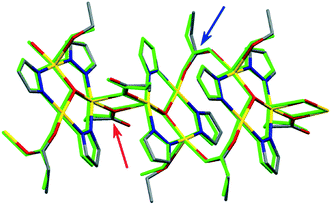 | ||
| Fig. 13 The 1D CPs generated by monatomic (red arrow) and syn–syn bridges (blue arrow) in 55 (structure shown in green color) and 63. H atoms have been removed for clarity. | ||
While the above results are reasonably expected due to the similarity between propanoate and acrylate chains, it is noteworthy that in some cases, even small changes in the synthetic procedures may generate large differences in the further assembly of the trinuclear clusters. As an example, even though the synthetic procedures leading to the two acrylate derivatives 63 and 62 (Hpz:copper acrylate = 1.2, solvent MeOH for 63 and Hpz:copper acrylate = 1.35, solvent H2O for 62) are very similar, 62 displays relevant differences compared to 63.57 Besides water, each trinuclear cluster of 62 also coordinates a molecule of Hpz, and one carboxylate ion has a chelating coordination while only the second one acts as a ditopic ligand (monatomic bridging), thus generating the hexanuclear assembly shown in Fig. 14. Incidentally, an analogous hexanuclear island, 56, was obtained from the reaction of copper butyrate with pyrazole in water, followed by recrystallization in MeOH.54
The influence of, seemingly irrelevant, different reaction conditions on the assembly of the TTC fragment is further evidenced by the synthesis of the propanoate-based TTC derivatives 53 and 52 (ref. 7) (Fig. 15).
These compounds differ only by a crystallization water molecule, which is present only in 52. They were obtained by reacting copper propanoate in water and, in contrast to compound 55 which was synthesized in EtOH,54 they do not assemble to form CPs, due to the monotopic coordination of the propanoate ions. Interestingly, the difference in the synthetic procedure leading to 52 and 53 consists only of the final crystallization process, which was carried out in the 18–22 °C range for 53, while 52 was recrystallized at 10–14 °C. This suggests that a slightly lower crystallization temperature is able to “freeze” a water molecule in the lattice of 52. Moreover, the presence of a further crystallization water molecule produces large differences in the supramolecular assemblies of 53 and 52. In 52, strong H-bonds involving coordinated and crystallization water molecules, as well as propanoate oxygens, connect the TTC assemblies generating parallel, almost cylindrical, helixes running alternatively clock- and counterclockwise (Fig. 16, left). H-bonds also drive the supramolecular assembly of compound 53, but in this case two 1D symmetry related supramolecular networks are formed, which are further connected through other H-bonds leading to the 1D supramolecular tape shown in Fig. 16, right.
 | ||
| Fig. 16 Supramolecular assemblies of 52 (left) and 53 (right). Pyrazolate carbon atoms and carbon-bonded H atoms have been removed for clarity. | ||
Other peculiar assemblies can be found in TTC derivatives with monocarboxylates as charge balancing ligands. In the methacrylate, cyclohexylcarboxylate and phenylacetate derivatives (compounds 64,5769 (ref. 58) and 66,58 respectively), the carboxylates double-connect two TTC moieties forming 12-membered metallacycles leading to 1D CPs. The differences among these CPS lie in the fact that in 66 both phenylacetates connect the TTC units in a syn–syn fashion, while in the other two cases one syn–syn and one syn–anti connection is present (Fig. 17).
A different kind of 1D CP has been found in the structure of the vinylacetate TTC derivative 67,58 where one vinylacetate anion joins two TTC units through a monatomic bridge, while the other one displays a syn–syn plus monatomic tritopic behavior, as shown in Fig. 18.
Interestingly, the coordination modes found in the vinylacetate TTC 67 are also present in the case of phenylpropanoate TTC derivative 68,58 but in this case only four trinuclear units are connected through two monatomic and two syn–syn plus monatomic bridges, yielding a dodecanuclear assembly which is capped by two coordinated water molecules (Fig. 19).
As evidenced above, most of the monocarboxylates lead to the formation of CPs with the TTC moiety as the SBU, and this feature is found a fortiori when di- or tricarboxylates are employed, as summarized in Table 3.
In detail, the hydrothermal reaction of copper fumarate or 2-methylfumarate with pyrazole yielded the isomorphous derivatives Cu3(μ3-OH)(μ-pz)3(fumarate)(Hpz), 71, and Cu3(μ3-OH)(μ-pz)3(methylfumarate)(Hpz), 72.60Fig. 20 reports the molecular structure of 71 and the 2D CP obtained through fumarate connections. The isomorphous derivative 72 displays almost the same geometrical parameters.
 | ||
| Fig. 20 The molecular structure of the fumarate TTC 71 (left) and the 2D CP obtained through the polytopic coordination of fumarate ions (right). H atoms have been removed for clarity. | ||
When the “flexible” succinate was employed instead of a “rigid” carboxylate like fumarate or 2-methylfumarate, three different CPs, 73, 74 and 75, were isolated.61 Compound 74, [Cu3(μ3-OH)(μ-pz)3(succinate)(H2O)2.5]·xH2O·yMeOH, was obtained from solvothermal reaction of sodium succinate, Hpz and copper sulfate in MeOH/H2O and a distinct, serendipitous, reaction yielded compound 73, [Cu3(μ3-OH)(μ-pz)3(succinate)(H2O)(MeOH)]·H2O. Compounds 74 and 73 crystallize in the same space group with almost identical cell parameters. In Fig. 21 (left), it is evident that the two structures are almost exactly superimposable. In both cases, succinate ions bridge the trinuclear fragments in a quite complex way, generating 3D porous CPs (with about 20% solvent accessible void space). The crystal lattice of 73 is shown in Fig. 21 (right), which evidences the porosity of this compound.
When compounds 74 or 73 were dried under vacuum at rt, not only crystallization, but also coordinated water and MeOH were easily removed, yielding the TTC derivative [Cu3(μ3-OH)(μ-pz)3(succinate)], 75, which was also obtained through hydrothermal reaction of copper succinate with Hpz.61 The structure of 75, displayed in Fig. 22 (left), exhibits some similarity with those of 74 and 73, but there are also some differences, mainly in the orientation of the succinate carbon chain, which is very likely responsible for (or vice-versa due to) the different assembly of the TTC units. The carboxylate moieties of each succinate display different (syn–syn and syn–anti) bridging modes, generating distinct 12-membered metallacycles that are connected through the C2 succinate chains, yielding a non-porous 3D CP.
Other bicarboxylates were employed in the synthesis of TTC derivatives, including 2-hydroxynaphthalene-1,4-bicarboxylate, biphenyl-4,4′-bicarboxylate and 3-pyridine-3,4-bicarboxylate, which yielded the 2D CP 76 and two 3D CPs (78 and 77), respectively,62 whose structures are shown in Fig. 23. Each 2D sheet of compound 76 presents evident pores; however, with the parallel sheets being arranged in an offset manner, no effective porosity is present. On the contrary, compounds 78 and 77 display true, non-connected pores or parallel channels, accounting for a solvent accessible void space of about 22% and 38%, respectively.
Finally, the solvothermal reaction of copper nitrate, Hpz and benzene-1,3,5-tricarboxylic acid yielded the already briefly discussed derivative 1,30 where each tricarboxylate connects three hexanuclear units (Fig. 24), resulting in an interpenetrated 3D CP.
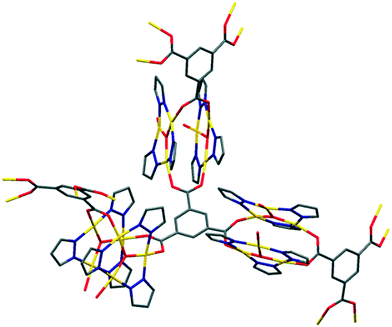 | ||
| Fig. 24 The structure of 1 evidencing how benzene-1,3,5-tricarboxylate bridges three couples of trinuclear units. H atoms have been removed for clarity. | ||
Reactivity
Reactions with strong acids
From all the literature data, it appears that even though different synthetic procedures are employed (for example, solvothermal or ambient reaction conditions, the presence of exogenous bases or the use of copper carboxylates), the TTC derivatives self-assemble quite easily, possibly suggesting that the TTC metallacycle has good stability. This assumption is reinforced by the results of the reaction of the acetate-based TTC derivative 50 (ref. 55) with some strong acids. Actually, by reacting 50 with a water solution of HCl,39 besides the mononuclear species Cu(Cl)2(Hpz)4, resulting from partial decomposition, two hexanuclear derivatives are also formed, the already mentioned compound 16 (see Fig. 3) and compound 32, where one or two acetates of 50 are replaced by chloride anion(s). In compound 32, H-bonds connect the hexanuclear island forming a 2D supramolecular network, partly shown in Fig. 25.From the reaction of 50 with HCl, a heptanuclear derivative, 31, was also formed,39 where two Cu3(μ3-OH)(μ-pz)3(Cl)2(Hpz)2(H2O) moieties are weakly bridged through the mononuclear Cu(Cl)2(Hpz)2 fragment (see Fig. 26, left). This weak interaction, associated with the ditopic behavior of one chloride ion coordinated to the TTC moiety and to H-bonds involving Cl and μ3-OH fragments, generates 2D supramolecular assemblies where pores are present. Moreover, these parallel sheets exactly match, forming small star-shaped channels accounting for a solvent accessible void space of about 8% (Fig. 26, right).
Compound 50 was reacted with other strong acids with similar results.31 In all cases, partial decomposition of the trinuclear unit, leading to the formation of mononuclear pyrazole derivatives, was observed. However, TTC derivatives were also formed. In detail, the reaction with H2SO4 yielded the 1D CP 42, whose structure is shown in Fig. 8, while the reaction with HClO4 generated the hexanuclear island 37 reported in Fig. 7. The reaction of 50 with HNO3 yielded two derivatives,31 the TTC species 27 and the 1D CP 28 reported in Fig. 5, which were previously synthesized through completely different procedures.45,46 Moreover, from the reaction of 50 with CF3COOH (ref. 31) the TTC derivative 51 was obtained (see Fig. 27), while the reaction with CF3SO3H generated two different compounds, the hexanuclear species 2, whose structure is shown in Fig. 1, and the TTC species 38 (ref. 31) reported in Fig. 6.
Finally, from the reaction of copper chloroacetate with Hpz, the dichloride hexanuclear cluster 17 was formed,40 which exhibits a structure almost superimposable to that of the previously discussed compound 16 (Fig. 28). As mentioned above, the reaction of copper carboxylates with Hpz results in the spontaneous self-assembly of the TTC fragment, provided that the carboxylate is basic enough to efficiently deprotonate water and Hpz, as evidenced, for example, by the failure to obtain the TTC moiety in the reaction of copper trifluoroacetate (pKbCF3COO = 13.48).55 In the reaction of copper chloroacetate (pKbClCH2COO = 11.13) with Hpz,40 the formation of a mononuclear 1D CP, [Cu(ClCH2COO)2(Hpz)2], and a tetranuclear derivative, [{Cu2(μ-pz)(μ-OCH2COO)(Hpz)(MeOH)}2(μ-ClCH2COO)2], was observed, the latter being obtained through an intramolecular dehydrochlorination reaction. The HCl released in this stage evidently attacked a (not isolated) hexanuclear species generating compound 17, analogous to what happens in the reaction of 50 with HCl, yielding compound 16.39 The formation of both [Cu(ClCH2COO)2(Hpz)2] and 17 in this reaction evidences that the pKbClCH2COO lies borderline between the values leading to the exclusive formation of mono and trinuclear species.
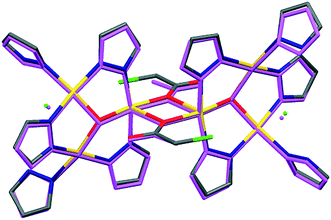 | ||
| Fig. 28 The superimposed structures of 16 (shown in magenta color) and 17. H atoms and crystallization water molecules of 16 have been omitted for clarity. | ||
Reactions with nucleophiles
Besides the reaction with strong acids, the TTC moiety also tolerates nucleophilic attacks, and it is possible to treat TTC derivatives with a nucleophile (Nu) obtaining the addition of Nu or the exchange of a pre-existing ligand with Nu. For example, by reacting the trinuclear compound [Cu3(μ3-OH)(μ-pz)3(Cl)2(Hpz)2]·solv [solv = H2O or THF] with pyridine (py), the TTC [Cu3(μ3-OH)(μ-pz)3(Cl)(μ-Cl)(py)2]·py derivative 34 was easily obtained.50 Reactions with nucleophiles have been largely exploited by using the ditopic 4,4′-bipyridine (bpy) to connect the TTC moieties with the aim of obtaining 1-, 2- or 3D CPs. In one case, bpy was employed directly during the synthetic procedure to obtain the TTC moiety. Actually, by reacting Cu(CF3SO3)2 with Hpz, NaOH and py,43 the TTC complex [Cu3(μ3-OH)(μ-pz)3(CF3SO3)(μ-CF3SO3)(py)3]·0.5H2O, 39, was obtained, while by also adding bpy and tuning the py/bpy ratio, it was possible to isolate the hexanuclear assembly 40, the 1D CP 41 and the interpenetrated 3D CP 25 (Fig. 29).In most cases bpy was instead added to pre-formed trinuclear species. By treating methanol solutions of the formate-based TTC 47 (ref. 54) with bpy, different compounds were obtained.41 When the bpy/Cu3 ratio was equal to 1, bpy displaced the Hpz molecules coordinated to copper ions in 47 and formed 1D tapes of compound 45 by connecting two 1D CPs (Fig. 30). Other weak coordinative interactions among these tapes generated a supramolecular 3D network.
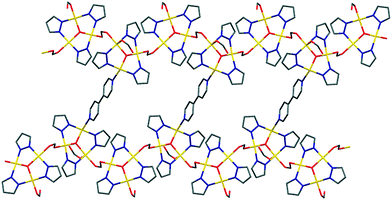 | ||
| Fig. 30 1D tape generated through bpy connections in 45. Coordinated and crystallization water molecules and H atoms have been removed for clarity. | ||
By using a higher bpy/Cu3 ratio,41 a formate anion was also displaced from 47 and it was replaced by an uncoordinated hydroxide ion, likely coming from adventitious water, generating the hexanuclear species 18 shown in Fig. 31. In compound 18, each TTC unit coordinates three bpy molecules, with two of them acting as monotopic ligands, and the third one connecting two TTC fragments. A series of strong H-bonds generates a 3D supramolecular network where two different channels are present, one of which is partly occupied by further crystallization bpy molecules, accounting for a solvent accessible void space of about 23%.
Interestingly, when crystals of 18 were soaked in benzene, toluene or cyclohexane, they lost crystallization bpy molecules which were replaced by these solvents, maintaining the original crystalline structure and almost identical cell parameters. On the other hand, if 18 was dissolved in MeOH, it decomposed yielding the above described species 45 and the derivative 46, in addition to the trinuclear triangular species 80, where the μ3-OH group is substituted by the μ3-OMe fragment. Compound 46 consists of two TTC moieties joined through a ditopic bpy (Fig. 32, left); moreover, each trinuclear fragment coordinates two formate anions, one of which acts as a monatomic O bridge between the two hexanuclear units. These ditopic connections generate 46-membered macrocycles (Fig. 32, right), which in turn lead to 2D waved CPs.41
The reaction of the TTC acetate derivative 50 (ref. 55) with bpy yielded results similar to those observed in the case of the formate derivative, with three bpy containing compounds, 48, 49 and 22, being obtained depending on the bpy/Cu3 reaction ratio.42 Compound 48, prepared in MeOH with bpy/Cu3 = 2, consists of the hexanuclear fragment shown in Fig. 33, left. Besides bpy molecules, one acetate ion also connects the TTC units through a monatomic O bridge, generating condensed 46-membered macrocycles (one of which is shown in Fig. 33, right), resulting in a series of parallel, but offset stacked, 2D CPs.
 | ||
| Fig. 33 The hexanuclear species 48 (left), where crystallization water and MeOH molecules are omitted for clarity. On the right a macrocycle generated through acetate and bpy bridges. | ||
With bpy/Cu3 = 4, the hexanuclear species 49 (Fig. 34) was instead obtained,42 where two trinuclear fragments are connected by two ditopic bpy molecules, with acetate anions behaving as monotopic ligands. Another monotopic bpy is coordinated to each trinuclear unit and further bpy molecules are present in the crystal lattice together with water and methanol.
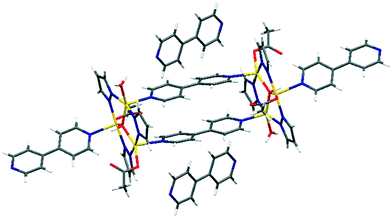 | ||
| Fig. 34 The hexanuclear species 49. Crystallization water and MeOH molecules are omitted for clarity. | ||
A further increase of the bpy/Cu3 ratio yielded the hexanuclear species 22 (ref. 42) which is isomorphous at rt with the previously discussed compound 18.41 Analogously to 18, the pores of compound 22, accounting for a solvent accessible void space of about 23%, partly contain bpy and, also in this case, soaking with suitable solvents leads to the exchange of this molecule. Moreover, a reversible single-crystal-to-single-crystal process, yielding the derivative 23, takes place on cooling 22 at 100 K. In Fig. 35, the structures of both 22 and 23 are shown, showing twisting of the structure on passing from rt to 100 K.
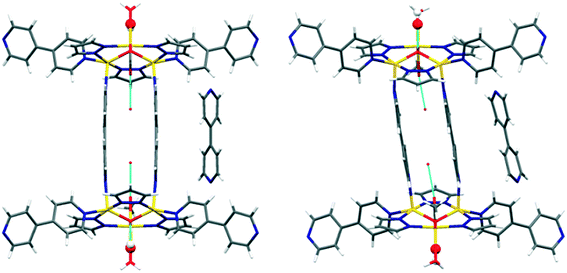 | ||
| Fig. 35 Molecular structures of the hexanuclear species 22 collected at rt (left), and 23 collected at 100 K (right). Uncoordinated OH ions are shown in ball-and-stick representation. | ||
The reaction of the propanoate TTC species 53 (ref. 7) with bpy yielded the hexanuclear compound 54 (ref. 42) characterized by a structure almost superimposable to that of the acetate-based derivative 48, as shown in Fig. 36. Also the 2D CP obtained through propanoate and bpy bridges is almost identical to that of 48.
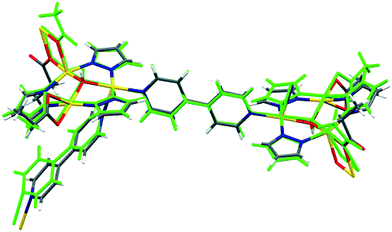 | ||
| Fig. 36 Molecular structure of the hexanuclear species 54 superimposed on that of 48 (shown in green color). Crystallization molecules have been removed from both structures for clarity. | ||
By reacting both the acrylate TTC derivatives 62 and 63 with bpy in a molar ratio bpy/Cu3 = 2, a unique compound, 60 (Fig. 37), was formed.42 Due to the ditopic behavior of one acrylate anion and bpy, a series of condensed 30-membered macrocycles generates a 1D tape as shown in Fig. 37.
 | ||
| Fig. 37 The molecular structures of 60 (left) and the 1D tape generated by condensed macrocycles (right), where H atoms have been omitted for clarity. | ||
When compound 62 was treated with a large excess of bpy (bpy/Cu3 = 8), the TTC species 61 was instead obtained.42 In this compound (see Fig. 38) acrylate anions behave as monotopic ligands, and the formation of a 1D tape is ensured by bpy. Moreover, due to peculiar competition between coordination and formation of a H-bond, only one bpy molecule acts as a ditopic ligand generating the tape, even though the second one also seems to have an orientation suitable for coordinating copper (Fig. 38, right).
The reactivity of TTC derivatives toward bpy in methanol was further tested on the butyrate TTC derivative 56,54 and also on the not structurally characterized valerate, hexanoate and heptanoate trinuclear species.9 The butyrate and hexanoate derivatives generated compounds 81 and 82, respectively,56 in which, analogously to compound 80,41 the capping μ3-OH is substituted by the μ3-OMe fragment. While compound 82 was obtained by using a high bpy/Cu3 ratio (8![[thin space (1/6-em)]](https://www.rsc.org/images/entities/char_2009.gif) :
:![[thin space (1/6-em)]](https://www.rsc.org/images/entities/char_2009.gif) 1), when a lower reaction ratio was employed, the TTC derivative 58 (Fig. 39, left) was formed and an analogous TTC structure (57) was obtained in the reaction of the valerate trinuclear derivative with bpy. Moreover, the assemblies of 58 and 57 are also almost identical56 and superimposable to that of the previously discussed acrylate derivative 60,42 as sketched in Fig. 39.
1), when a lower reaction ratio was employed, the TTC derivative 58 (Fig. 39, left) was formed and an analogous TTC structure (57) was obtained in the reaction of the valerate trinuclear derivative with bpy. Moreover, the assemblies of 58 and 57 are also almost identical56 and superimposable to that of the previously discussed acrylate derivative 60,42 as sketched in Fig. 39.
 | ||
| Fig. 39 Molecular structure of 58 (left) and partial sketches of superimposed 1D tapes of 58 (blue), 57 (green) and 60 (red) (right), where H atoms have been omitted for clarity. | ||
Finally, the reaction of the non-structurally characterized heptanoate trinuclear derivative9 with bpy yielded the hexanuclear compound 59,56 where the ditopic behavior of one carboxylate and bpy generate the 1D CP shown in Fig. 40.
 | ||
| Fig. 40 Molecular structure of 59 (left) and partial sketch of the 1D CP (right), where H atoms have been omitted for clarity. | ||
Applications and characteristics
From the literature, it appears that the TTC derivatives are potentially interesting for some useful applications. First of all, the triangular copper(II) array, which has a geometry close to the equilateral one, offers the opportunity to study the so called spin-frustration phenomenon.3,11,12,65 Actually, a large number of reports concerning TTC derivatives evidence the occurrence of magnetic exchange, leading to magnetic moment values close to that corresponding to one unpaired electron, thus indicating strong antiferromagnetic coupling.7,9,31,39,41,42,45–47,49,50,52–58,60,61,63 In some cases, further coupling between TTC units occurs, likely due to H-bonds or other supramolecular interactions,45,46,52 while only for compounds 76–78, strong ferromagnetic coupling has been reported.62Likely due to intrinsic difficulties in correctly mimicking the structural and electronic features of “true” TTC derivatives containing coordinated water, alcohols, pyrazole or other nitrogen ligands, in addition to the Cu3(μ3-OH)(μ-pz)3 fragment and charge balancing anion(s), and often displaying strong supramolecular interactions, theoretical calculations on TTC moieties have been performed in a few cases. More specifically, theoretical calculations based on density functional theory have provided insights into the electronic structure of TTC derivatives,55 allowed the accurate assignment of TTC UV-vis spectra,54 indicated a possible mechanism of the H+ electrophilic attack to a TTC moietiy,39 and enabled a possible pathway to be proposed for the formation of the tetranuclear derivative [{Cu2(μ-pz)(μ-OCH2COO)(Hpz)(MeOH)}2(μ-ClCH2COO)2], obtained in the reaction of copper(II) chloroacetate with Hpz.40 Moreover, theoretical calculations have also been employed to explore the nature of TTC magnetic exchange.47,49,50,52,53,63
TTC derivatives have been tested as catalysts (or catalyst precursors) in a number of relevant reactions, and have been shown to be active in cyclopropanation,55 photodegradation of organic dyes,30,62 peroxidative oxidation of cycloalkanes,7,9,41,57 and styrene oxidation by H2O2.60 While in most cases the TTC compounds are dissolved in the reaction media and the identity of the active species is uncertain, the photodegradation of organic dyes can occur in heterogeneous conditions,30,62 using CPs with TTC moieties as SBUs. On the other hand, it should be noted that when TTC derivatives were dissolved in reaction media in the presence of acid and a small quantity of oxidants, the permanence of the trinuclear structure was confirmed by spectroscopy, further suggesting that TTC-derivatives could be the catalytic species.
It is relevant that TTC units can be employed as SBUs to build stable CPs, as evidenced by the isolation of compounds 1 and 71–78. In this context, and taking into account the displacement of monocarboxylate ions by strong acids (compounds 2, 16, 17, 27, 28, 31, 32, 37, 38, 42 and 51), it is reasonable to expect that the reaction of TTCs based on monocarboxylates with suitable bi- or tricarboxylic acids may lead to the formation of polydimensional CPs, possibly characterized by tunable porosity. Moreover, the reaction of TTC-containing compounds with suitable di-, tri- or polytopic nucleophiles yielded numerous 1-, 2- and 3D CPs (compounds 25, 40, 41, 45, 46, 48, 54, 57–61), supramolecular porous derivatives (compounds 18–23), and a hexanuclear derivative (compound 49), in addition to an interpenetrated 3D CP (80) and two 1D CPs (81 and 82) where the μ3-OH is substituted by a μ3-OMe moiety.
Finally, Wang et al.66 employed the [Cu3(μ3-OH)(μ-pz)3(MeCOO)2(Hpz)] derivative 50 as a precursor in a solvothermal reaction leading to the formation of a peculiar copper(I) derivative Cu2L (L = 3,3′,5,5′-tetraethyl-4,4′-bipyrazolate) which self-assembles generating a very stable porous 3D CP useful for selective hydrocarbon sorption in water.
Conclusions and perspectives
Neutral and ionic trinuclear triangular CuII arrays based on the Cu3(μ3-OH)(pz)3 moiety can be easily prepared by reaction of copper(II) carboxylates with Hpz and water, through a spontaneous self-assembly process when the basicity of the carboxylate or of the anionic counter-ion is adequate to yield sufficient amounts of pz− and OH− anions or upon addition of an exogenous base or though solvothermal reactions. This reaction is very significant as copper complexes with varying nuclearity are the active sites of a number of proteins and enzymes, and in the last few years several researchers have encapsulated, for example, copper(II) acetate in zeolites in order to activate O2 and mimic the oxygenase activity of enzymes.67 A systematic and detailed study on the reaction between unsubstituted pyrazole and more than 25 different copper(II) carboxylates has been performed, highlighting all of the specific spectroscopic and structural features of the TTCs produced.68Substantially different structures can be obtained depending on the counter-ion denticity and flexibility, the employed solvent, and the capability of all of the species to generate supramolecular structures through coordinative and H-bonds or van der Waals interactions, leading in several cases to the formation of 1D, 2D or 3D CPs. Particularly, 3D CPs, in some cases porous, can be easily obtained by using di- or tricarboxylates.
The TTC moiety is very stable, often being resistant to strong acid attacks which displace the original counter-ion(s) maintaining, to a relevant extent, the triangular array. By exploiting this reactivity, new CPs and supramolecular networks characterized by different porosity and solubility can be generated. The TTC fragment is also tolerant to several nucleophiles such as mono-dentate N-donor ligands or multitopic bridging species such as 4,4′-bpy, which upon displacement of monodentate ligands can connect each other in single TTC arrays, generating polydimensional CPs or supramolecular networks.
The relevant stability of the TTC moieties is likely the key to their possible future uses. Particularly, the possibility to react TTC-containing compounds with suitable di-, tri- or polytopic nucleophiles opens the way to employing these derivatives as building blocks according to crystal engineering procedures.
Even though a relatively low number of applications for these TTC arrays have been reported, they have been efficiently employed as catalysts or catalyst precursors in some relevant reactions. Finally, TTC derivatives have magnetic properties related to the spin-frustration phenomenon, displaying magnetic susceptibility approximately corresponding to one unpaired electron.
Acknowledgements
The Universities of Padova and Camerino are acknowledged for funds. The authors are indebted to the following colleagues and students who, in the last twelve years, have contributed to studies in the fascinating world of TTCs: S. Carlotto, M. Casarin, A. Cingolani, F. Condello, S. Contaldi, C. Corvaja, M. F. C. G. da Silva, C. Di Nicola, D. Falcomer, L. Franco, E. Forlin, F. Garau, M. Gazzano, Y. Yu. Karabach, A. M. Kirillov, A. Lanza, L. M. D. R. S. Martins, N. Masciocchi, S. Massignani, M. Monari, M. M. Natile, F. Nestola, A. J. L. Pombeiro, R. Pettinari, F. Piccinelli, D. Pucci, R. Scatena, P. Tagliatesta, A. Zorzi, F. Zorzi.Notes and references
- G. A. Ardizzoia, S. Cenini, M. Moret and N. Masciocchi, Inorg. Chem., 1991, 30, 4347 CrossRef CAS
.
- G. A. Ardizzoia, M. Angaroni, G. La Monica, C. Cariati, S. Cenini, N. Masciocchi and M. Moret, Inorg. Chem., 1994, 33, 1458 CrossRef CAS
.
- A. P. Cole, D. E. Root, P. Mukherjee, E. I. Solomon and T. D. P. Stack, Science, 1996, 273, 1848 CrossRef PubMed
.
- V. Mahadevan, R. Gebbink and T. D. P. Stack, Curr. Opin. Chem. Biol., 2000, 4, 228 CrossRef CAS PubMed
.
- W. B. Tolman and E. A. Lewis, Chem. Rev., 2004, 104, 1047 CrossRef PubMed
.
- A. M. Kirillov, M. N. Kopylovich, M. V. Kirillova, M. Haukka, M. F. C. Guedes da Silva and A. J. L. Pombeiro, Angew. Chem., Int. Ed., 2005, 44, 4345 CrossRef CAS PubMed
.
- C. Di Nicola, Y. Yu. Karabach, A. M. Kirillov, M. Monari, L. Pandolfo, C. Pettinari and A. J. L. Pombeiro, Inorg. Chem., 2007, 46, 221 CrossRef CAS PubMed
.
- R. A. Himes and K. D. Karlin, Curr. Opin. Chem. Biol., 2009, 13, 119 CrossRef CAS PubMed
.
- C. Di Nicola, F. Garau, Y. Y. Karabach, L. M. D. R. S. Martins, M. Monari, L. Pandolfo, C. Pettinari and A. J. L. Pombeiro, Eur. J. Inorg. Chem., 2009, 666 CrossRef CAS
.
- S. Hazra, S. Mukherjee, M. F. C. Guedes da Silva and A. J. L. Pombeiro, RSC Adv., 2014, 4, 48449 RSC
.
-
Magnetic Molecular materials, ed. D. Gatteschi, O. Kahn, J. S. Miller and F. Palacio, NATO ASI Series 198, Kluwer Academic Publishers, Dordrecht, The Netherlands, 1991 Search PubMed
.
- S. Ferrer, F. Lloret, I. Bertomeu, G. Alzuet, J. Borras, S. Garcia-Granda, M. Liu-Gonzalez and J. G. Haasnoot, Inorg. Chem., 2002, 41, 5821 CrossRef CAS PubMed
.
- J.-C. Liu, G.-C. Guo, J.-S. Huang and X.-Z. You, Inorg. Chem., 2003, 42, 235 CrossRef CAS PubMed
.
- J. Yoon and E. I. Solomon, Coord. Chem. Rev., 2007, 251, 379 CrossRef CAS
.
- T. Afrati, C. Dendrinou-Samara, C. Raptopoulou, A. Terzis, V. Tangoulis, A. Tsipis and D. P. Kessissoglou, Inorg. Chem., 2008, 47, 7545 CrossRef CAS PubMed
.
- W. Ouellette, H. Liu, C. J. O'Connor and J. Zubieta, Inorg. Chem., 2009, 48, 4655 CrossRef CAS PubMed
.
- K. Darling, W. Ouellette, A. Prosvirin, S. Freund, K. Dunbar and J. Zubieta, Cryst. Growth Des., 2012, 12, 2662 CAS
.
- S. Ferrer, F. Lloret, E. Pardo, J. Clemente-Juan, M. Liu-Gonzalez and S. Garcia-Granda, Inorg. Chem., 2012, 51, 985 CrossRef CAS PubMed
.
- A. Escuer, G. Vlahopoulou, F. Lloret and F. A. Mautner, Eur. J. Inorg. Chem., 2014, 83 CrossRef CAS
.
- M. Dong, P. Yang, X. Liu, B. Xia, Z. Chen, Y. Ling, L. Weng, Y. Zhou and J. Sun, Cryst. Growth Des., 2015, 15, 1526 Search PubMed
.
- A. Messerschmidt, A. Ressi, R. Ladenstein, R. Huber, M. Bolognesi, G. Gatti, A. Marchesini and A. Finazzi-Agro, J. Mol. Biol., 1989, 206, 513 CrossRef CAS PubMed
.
- R. Huber, Angew. Chem., Int. Ed. Engl., 1989, 28, 848 CrossRef
.
- A. Messerschmidt, R. Ladenstein, R. Huber, M. Bolognesi, L. Avigliano, R. Petruzzelli, A. Rossi and A. Finazzi-Agro, J. Mol. Biol., 1992, 224, 179 CrossRef CAS PubMed
.
- E. I. Solomon, U. M. Sundaram and T. E. Machonkin, Chem. Rev., 1996, 96, 2563 CrossRef CAS PubMed
.
- W. Kaim and J. Rall, Angew. Chem., Int. Ed. Engl., 1996, 35, 43 CrossRef CAS
.
- R. H. Holm, P. Kennepohl and E. I. Solomon, Chem. Rev., 1996, 96, 2239 CrossRef CAS PubMed
.
- S.-K. Lee, S. DeBeer George, W. E. Antholine, B. Hedman, K. O. Hodgson and E. I. Solomon, J. Am. Chem. Soc., 2002, 124, 6180 CrossRef CAS PubMed
.
- E. I. Solomon, A. J. Augustine and J. Yoon, Dalton Trans., 2008, 3921 RSC
.
- CCDC researches were carried out at November, 2016. Compounds where also metal different from copper are present have been excluded.
- H. Zhang, Y. Lu, Z.-M. Zhang and E.-B. Wang, Inorg. Chem. Commun., 2012, 17, 9 CrossRef CAS
.
- C. Di Nicola, F. Garau, M. Gazzano, M. Monari, L. Pandolfo, C. Pettinari and R. Pettinari, Cryst. Growth Des., 2010, 10, 3120 CAS
.
- G. Mezei, M. Rivera-Carrillo and R. G. Raptis, Dalton Trans., 2007, 37 RSC
.
- G. Mezei, J. E. McGrady and R. G. Raptis, Inorg. Chem., 2005, 44, 7271 CrossRef CAS PubMed
.
- P. A. Angaridis, P. Baran, R. Boca, F. Cervantes-Lee, W. Haase, G. Mezei, R. G. Raptis and R. Werner, Inorg. Chem., 2002, 41, 2219 CrossRef CAS PubMed
.
- G. Mezei, Chem. Commun., 2015, 51, 10341 RSC
.
- G. Mezei, M. Rivera-Carrillo and R. G. Raptis, Inorg. Chim. Acta, 2004, 357, 3721 CrossRef CAS
.
- M. Rivera-Carrillo, I. Chakraborty, G. Mezei, R. D. Webster and R. G. Raptis, Inorg. Chem., 2008, 47, 7644 CrossRef CAS PubMed
.
- M. A. Yakovleva, E. V. Kushan, N. S. Boltacheva, V. I. Filyakova and S. E. Nefedov, Zh. Neorg. Khim., 2012, 57, 181 CAS
.
- M. Casarin, A. Cingolani, C. Di Nicola, D. Falcomer, M. Monari, L. Pandolfo and C. Pettinari, Cryst. Growth Des., 2007, 7, 676 CAS
.
- S. Carlotto, M. Casarin, A. Lanza, F. Nestola, L. Pandolfo, C. Pettinari and R. Scatena, Cryst. Growth Des., 2015, 15, 5910 CAS
.
- C. Di Nicola, F. Garau, M. Gazzano, M. F. C. G. da Silva, A. Lanza, M. Monari, F. Nestola, L. Pandolfo, C. Pettinari and A. J. L. Pombeiro, Cryst. Growth Des., 2012, 12, 2890 CAS
.
- C. Di Nicola, F. Garau, M. Gazzano, A. Lanza, M. Monari, F. Nestola, L. Pandolfo and C. Pettinari, Cryst. Growth Des., 2015, 15, 1259 CAS
.
- M. Rivera-Carrillo, I. Chakraborty and R. G. Raptis, Cryst. Growth Des., 2010, 10, 2606 CAS
.
- M. R. Razali, A. Urbatsch, G. B. Deacon and S. R. Batten, Polyhedron, 2013, 64, 352 CrossRef CAS
.
- A. Alsalme, M. Ghazzali, R. A. Khan, K. Al-Farhan and J. Reedijk, Polyhedron, 2014, 75, 64 CrossRef CAS
.
- F. B. Hulsbergen, R. W. M. ten Hoedt, G. C. Verschoor, J. Reedijk and A. L. Spek, J. Chem. Soc., Dalton Trans., 1983, 539 RSC
.
- J. A. Sheikh, H. S. Jena, A. Adhikary, S. Khatua and S. Konar, Inorg. Chem., 2013, 52, 9717 CrossRef CAS PubMed
.
- K. Sakai, Y. Yamada, T. Tsubomura, M. Yabuki and M. Yamaguchi, Inorg. Chem., 1996, 35, 542 CrossRef CAS PubMed
.
- Y. M. Davydenko, S. Demeshko, V. A. Pavlenko, S. Dechert, F. Meyer and I. O. Fritsky, Z. Anorg. Allg. Chem., 2013, 639, 1472 CrossRef CAS
.
- M. Angaroni, G. A. Ardizzoia, T. Beringhelli, G. La Monica, D. Gatteschi, N. Masciocchi and M. Moret, J. Chem. Soc., Dalton Trans., 1990, 3305 RSC
.
- W. A. Wallace, G. J. Nilsen, B. D. Piazza, M. Mourigal, J. Hauser, H. M. Ronnow and K. W. Kramer, CSD Communication (Private Communication), 2014 Search PubMed.
- Q.-J. Zhou, Y.-Z. Liu, R.-L. Wang, J.-W. Fu, J.-Y. Xu and J.-S. Lou, J. Coord. Chem., 2009, 62, 311 CrossRef CAS
.
- L.-L. Zheng, J.-D. Leng, S.-L. Zheng, Y.-C. Zhaxi, W.-X. Zhang and M.-L. Tong, CrystEngComm, 2008, 10, 1467 RSC
.
- M. Casarin, C. Corvaja, C. Di Nicola, D. Falcomer, L. Franco, M. Monari, L. Pandolfo, C. Pettinari and F. Piccinelli, Inorg. Chem., 2005, 44, 6265 CrossRef CAS PubMed
.
- M. Casarin, C. Corvaja, C. Di Nicola, D. Falcomer, L. Franco, M. Monari, L. Pandolfo, C. Pettinari, F. Piccinelli and P. Tagliatesta, Inorg. Chem., 2004, 43, 5865 CrossRef CAS PubMed
.
- F. Condello, F. Garau, A. Lanza, M. Monari, F. Nestola, L. Pandolfo and C. Pettinari, Cryst. Growth Des., 2015, 15, 4854 CAS
.
- S. Contaldi, C. Di Nicola, F. Garau, Y. Yu. Karabach, L. M. D. R. S. Martins, M. Monari, L. Pandolfo, C. Pettinari and A. J. L. Pombeiro, Dalton Trans., 2009, 4928 RSC
.
- S. Massignani, R. Scatena, A. Lanza, M. Monari, F. Condello, F. Nestola, C. Pettinari, F. Zorzi and L. Pandolfo, Inorg. Chim. Acta, 2017, 455, 618 CrossRef CAS
.
- L. Mathivathanan, M. Rivera-Carrillo and R. G. Raptis, Inorg. Chim. Acta, 2012, 391, 201 CrossRef CAS
.
- C. Di Nicola, E. Forlin, F. Garau, A. Lanza, M. M. Natile, F. Nestola, L. Pandolfo and C. Pettinari, J. Organomet. Chem., 2012, 714, 74 CrossRef CAS
.
- C. Di Nicola, E. Forlin, F. Garau, M. Gazzano, A. Lanza, M. Monari, F. Nestola, L. Pandolfo, C. Pettinari, A. Zorzi and F. Zorzi, Cryst. Growth Des., 2013, 13, 126 CAS
.
- S. Bala, S. Bhattacharya, A. Goswami, A. Adhikary, S. Konar and R. Mondal, Cryst. Growth Des., 2014, 14, 6391 CAS
.
- L. Mathivathanan, K. Al-Ameed, K. Lazarou, Z. Trávníček, Y. Sanakis, R. Herchel, J. E. McGrady and R. G. Raptis, Dalton Trans., 2015, 44, 20685 RSC
.
- M. Eddaudi, D. B. Moler, H. Li, B. Chen, T. M. Reineke, M. O'Keeffe and O. M. Yaghi, Acc. Chem. Res., 2001, 34, 319 CrossRef
.
- O. Kahn, Chem. Phys. Lett., 1997, 265, 109 CrossRef CAS
.
- J.-H. Wang, M. Li and D. Li, Chem. – Eur. J., 2014, 20, 12004 CrossRef CAS PubMed
.
- C. L. Hill and I. A. Weinstock, Nature, 1997, 388, 332 CrossRef CAS
.
- C. Pettinari, N. Masciocchi, L. Pandolfo and D. Pucci, Chem. – Eur. J., 2010, 16, 1106 CrossRef CAS PubMed
.
Footnotes |
| † Electronic supplementary information (ESI) available. See DOI: 10.1039/c7ce00009j |
‡ Hereafter, the acronym TTC (![[T with combining low line]](https://www.rsc.org/images/entities/char_0054_0332.gif) rinuclear rinuclear ![[T with combining low line]](https://www.rsc.org/images/entities/char_0054_0332.gif) riangular riangular ![[C with combining low line]](https://www.rsc.org/images/entities/char_0043_0332.gif) opper) will be used to represent the Cu3(μ3-OH)(μ-pz)3 moiety. opper) will be used to represent the Cu3(μ3-OH)(μ-pz)3 moiety. |
| § Hereafter, the structurally characterized compounds will be indicated using consecutive bold numbers. In Table 1 a complete list of the discussed compounds is reported, accompanied by the corresponding identifiers and compound names found in the Structure Navigator of the Mercury 3.8 CCDC database. |
| ¶ If not otherwise stated, in all the figures cyan and red dotted lines indicate H-bonds and hanging H-bonds, respectively. |
| This journal is © The Royal Society of Chemistry 2017 |

